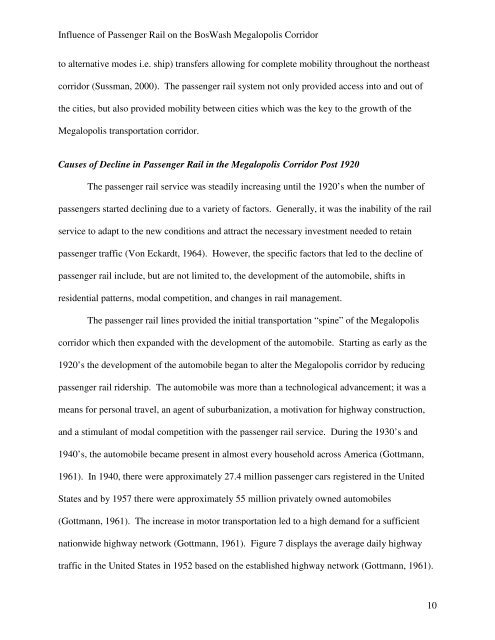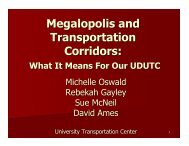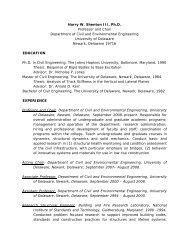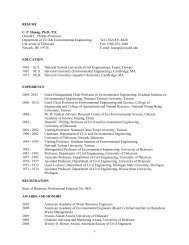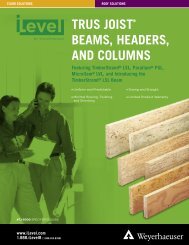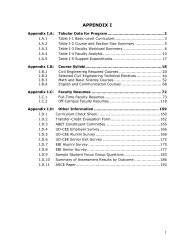Influence of Passenger Rail on the BosWash Megalopolis Corridor ...
Influence of Passenger Rail on the BosWash Megalopolis Corridor ...
Influence of Passenger Rail on the BosWash Megalopolis Corridor ...
Create successful ePaper yourself
Turn your PDF publications into a flip-book with our unique Google optimized e-Paper software.
<str<strong>on</strong>g>Influence</str<strong>on</strong>g> <str<strong>on</strong>g>of</str<strong>on</strong>g> <str<strong>on</strong>g>Passenger</str<strong>on</strong>g> <str<strong>on</strong>g>Rail</str<strong>on</strong>g> <strong>on</strong> <strong>the</strong> <strong>BosWash</strong> <strong>Megalopolis</strong> <strong>Corridor</strong><br />
to alternative modes i.e. ship) transfers allowing for complete mobility throughout <strong>the</strong> nor<strong>the</strong>ast<br />
corridor (Sussman, 2000). The passenger rail system not <strong>on</strong>ly provided access into and out <str<strong>on</strong>g>of</str<strong>on</strong>g><br />
<strong>the</strong> cities, but also provided mobility between cities which was <strong>the</strong> key to <strong>the</strong> growth <str<strong>on</strong>g>of</str<strong>on</strong>g> <strong>the</strong><br />
<strong>Megalopolis</strong> transportati<strong>on</strong> corridor.<br />
Causes <str<strong>on</strong>g>of</str<strong>on</strong>g> Decline in <str<strong>on</strong>g>Passenger</str<strong>on</strong>g> <str<strong>on</strong>g>Rail</str<strong>on</strong>g> in <strong>the</strong> <strong>Megalopolis</strong> <strong>Corridor</strong> Post 1920<br />
The passenger rail service was steadily increasing until <strong>the</strong> 1920’s when <strong>the</strong> number <str<strong>on</strong>g>of</str<strong>on</strong>g><br />
passengers started declining due to a variety <str<strong>on</strong>g>of</str<strong>on</strong>g> factors. Generally, it was <strong>the</strong> inability <str<strong>on</strong>g>of</str<strong>on</strong>g> <strong>the</strong> rail<br />
service to adapt to <strong>the</strong> new c<strong>on</strong>diti<strong>on</strong>s and attract <strong>the</strong> necessary investment needed to retain<br />
passenger traffic (V<strong>on</strong> Eckardt, 1964). However, <strong>the</strong> specific factors that led to <strong>the</strong> decline <str<strong>on</strong>g>of</str<strong>on</strong>g><br />
passenger rail include, but are not limited to, <strong>the</strong> development <str<strong>on</strong>g>of</str<strong>on</strong>g> <strong>the</strong> automobile, shifts in<br />
residential patterns, modal competiti<strong>on</strong>, and changes in rail management.<br />
The passenger rail lines provided <strong>the</strong> initial transportati<strong>on</strong> “spine” <str<strong>on</strong>g>of</str<strong>on</strong>g> <strong>the</strong> <strong>Megalopolis</strong><br />
corridor which <strong>the</strong>n expanded with <strong>the</strong> development <str<strong>on</strong>g>of</str<strong>on</strong>g> <strong>the</strong> automobile. Starting as early as <strong>the</strong><br />
1920’s <strong>the</strong> development <str<strong>on</strong>g>of</str<strong>on</strong>g> <strong>the</strong> automobile began to alter <strong>the</strong> <strong>Megalopolis</strong> corridor by reducing<br />
passenger rail ridership. The automobile was more than a technological advancement; it was a<br />
means for pers<strong>on</strong>al travel, an agent <str<strong>on</strong>g>of</str<strong>on</strong>g> suburbanizati<strong>on</strong>, a motivati<strong>on</strong> for highway c<strong>on</strong>structi<strong>on</strong>,<br />
and a stimulant <str<strong>on</strong>g>of</str<strong>on</strong>g> modal competiti<strong>on</strong> with <strong>the</strong> passenger rail service. During <strong>the</strong> 1930’s and<br />
1940’s, <strong>the</strong> automobile became present in almost every household across America (Gottmann,<br />
1961). In 1940, <strong>the</strong>re were approximately 27.4 milli<strong>on</strong> passenger cars registered in <strong>the</strong> United<br />
States and by 1957 <strong>the</strong>re were approximately 55 milli<strong>on</strong> privately owned automobiles<br />
(Gottmann, 1961). The increase in motor transportati<strong>on</strong> led to a high demand for a sufficient<br />
nati<strong>on</strong>wide highway network (Gottmann, 1961). Figure 7 displays <strong>the</strong> average daily highway<br />
traffic in <strong>the</strong> United States in 1952 based <strong>on</strong> <strong>the</strong> established highway network (Gottmann, 1961).<br />
10


